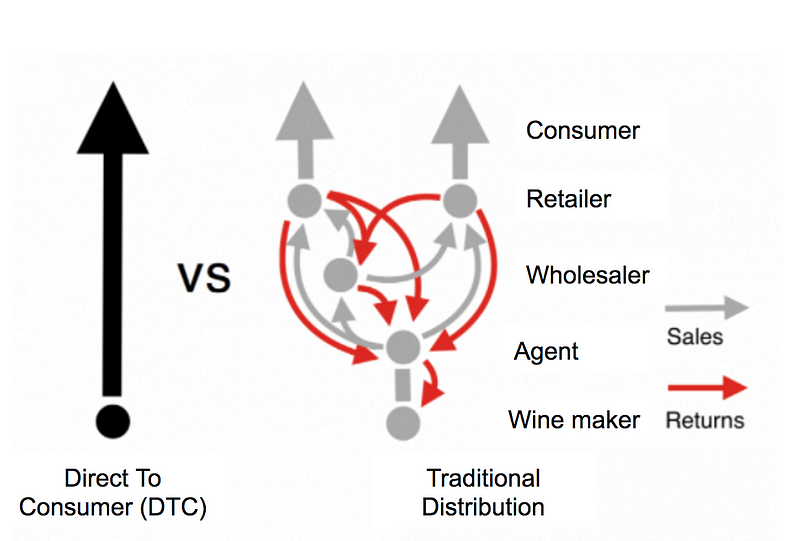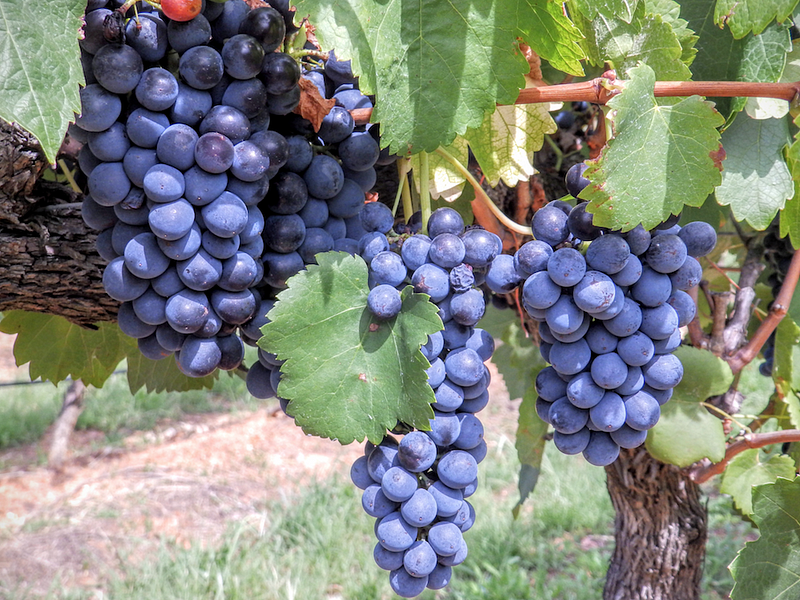What Direct To Consumer represents for genuine wine makers
Direct To Consumer (DTC) is a major trend worldwide.
DTC affects or will affect every area of our lives.
Authors interact directly with their readers and, often, blog then self-edit their book. Brands often offer a way to buy online, competing with their distributors. TV will either bypass the distributors and move online or die (because of Netflix). Car manufacturer Tesla only sells direct. IKEA furniture company won a sector leadership position by relying only on DTC. Apple computers are available online or in lovely designed Apple stores owned by Apple.
These are only a few examples from various industries. It proves that in many sectors, intermediaries are under duress. Layer after layer of intermediaries are put out of business on a daily basis.
What is DTC ?#
DTC is the leanest business model: One producer and one buyer connected.
No intermediary, no fuss.
Simple and elegant.

Bonuses :
- the producer (or brand) can now converse with the consumer;
- The consumer, thirsty for new information, can learn the brand story;
- The advanced consumer can now influence the future products & services.
Often, DTC relies heavily on direct referrals. Your own customers help you find new customers by sharing your story, sometimes for a perk or benefit.
Think about it: Who do you trust more: a friend or an ad ?A recent Forrester study found that 70% of the consumers trust brand recommendation from friends.
Wine. Why wine ?#
The current distribution model for wineries is a multi tiered system. To find a distributor wineries have to rely on an agent. The agent then looks for a distributor. The distributor then distributes or exports their unique product.
The wines end up in brick and mortar shops (another intermediary!). Each shop contains only a fraction of the wines produced worldwide at a high cost for the consumer.

All in all, a winery’s revenue is often no more than 40% of the retail price. Make it 20% or less if the wine is sold internationally.
The consequence of the multi-tier distribution model is daunting.
As Cathy Huygue (Wine columnist @Forbes and Food52) points out in her blog, out of 8,287 wineries in the U.S., 30 of them represent almost 90% of the volume of wine sold domestically each year.
What can a boutique, small or medium winery do about it ?
Bypass the legacy distribution system!
By selling their wine DTC, wineries take back the control of their brand. They have more control over the price and costs. This translates in higher revenue, much greater profit and better cash flow.
On the consumer’s side, DTC guarantees that they know what they are drinking. They are more capable of making an informed decision when picking a wine. No more guessing game at the bottle shop: a single visit on a search engine, Twitter, Instagram, Facebook or even a chat with a mate and they will have proof that the winery is legit, with real people and real story behind it.
DTC is happening, even for large wineries. Rob McMillan, SVB on wine and author of the “State of the Industry wine report 2016” wrote : “Today the smaller producers absolutely could not live without direct sales, and when we say small in this context, we are talking about wineries with less than 100,000 in case sales.” (p38)
 on DTC](https://radicaloptimist.org/images/max/800/1-tqxvyazhly1gba11wpllkg.png)
DTC is the leanest and simplest business model. We envision it as the principal growth channel for independent wineries. What are the key challenges (matter for future articles!) :
- Regulation: shipping nationally (US & Canada) is a challenge.
- International shipment is even more challenging : complexity, cost, time to the consumer, etc.
- Monopoly (state-based agency that control alcohol distribution in various states/provinces or countries)
- Quasi monopoly (private) of the distribution channel. Large international players own the low-end and industrial market. They will fight for their survival.
- IT : Many wine makers are of the Baby Boomer generation. They often see the winery as a down to earth activity where IT plays a secondary role.
Independent winemakers have to gear up and become a complete self sufficient operation. They have to provide the ease of use and fulfillment capabilities of amazon. It means :
- acquire and set-up various cloud-based IT systems
- create a DTC brand
- make it thrive on the social networks
- engage with customers both in person (cellar door) and on the Internet
DTC or die ?#
Many challenges await independent wine makers. The most complex and critical one is finding customers who love their unique product.
We have demonstrated, in this article, that the multi tiered distribution model can not help.
This distribution channel is already dominated by industry juggernauts. They control distribution, bottle-shops and have bought or built many industrial wineries. Their production capacity is superior to the demand for their industrial products. Moreover, this market segment is expected to shrink in the following years.
They have started to focus on boutique and medium wineries. Merger and acquisition for 2016 are expected to grow steadily.
](https://radicaloptimist.org/images/max/800/1-4uxarzasgjgzplojn9rlja.png)
However, current and future consumers (millennials) rely more and more on friends, family and social reference to buy online. They look for authentic products and are ready to pay more for these.
Now is a good time to be a boutique, small or medium winemaker.
Providing one can tap into the DTC channels and fulfill customers expectations (online access, social interaction, easy to buy online, good fulfillment), genuine and authentic products will be able to compete head to head with premium wine and industry juggernaut.
Feedback is a gift 🙏: Please do not hesitate to share your thoughtsts
- via the contact page form
- via a LinkedIn connexion or message